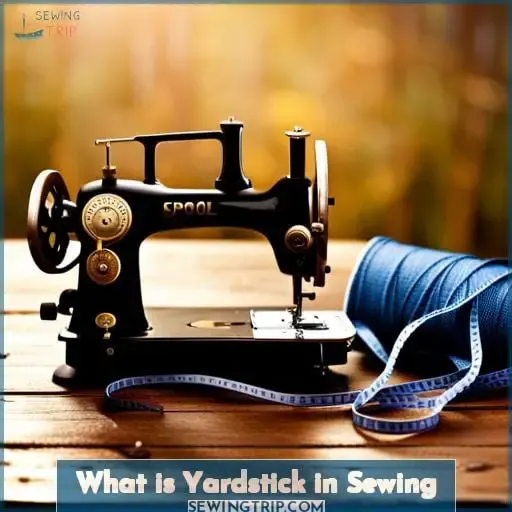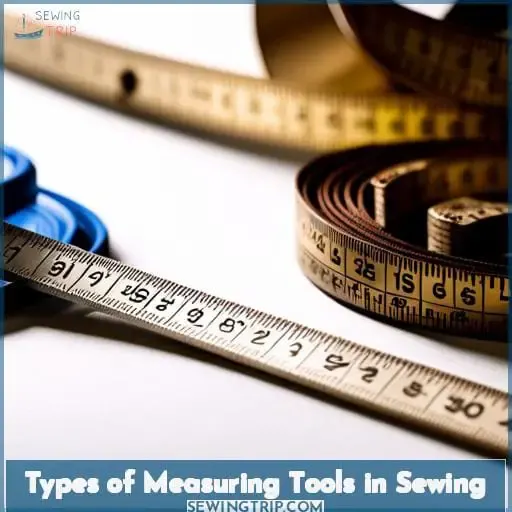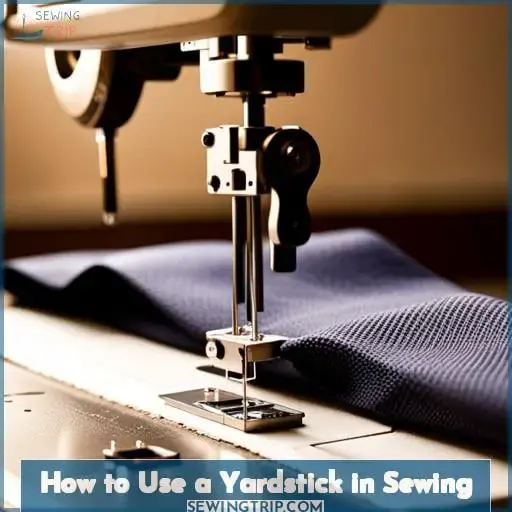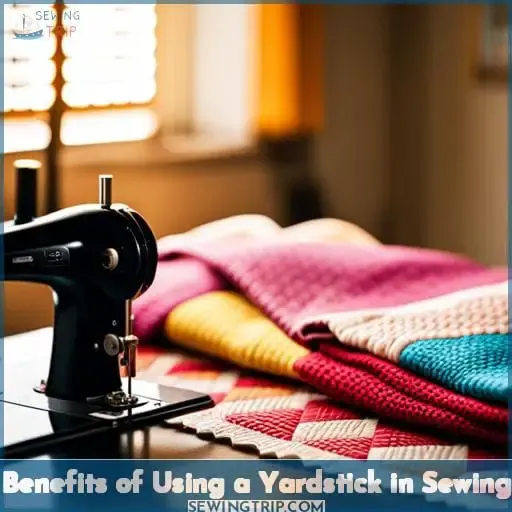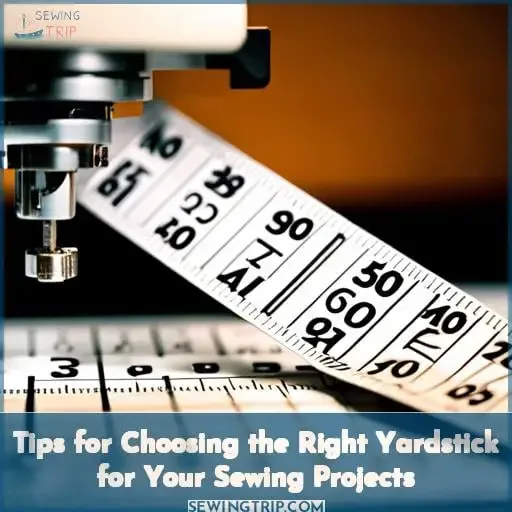This site is supported by our readers. We may earn a commission, at no cost to you, if you purchase through links.
Welcome to the world of sewing! Whether you’re a beginner or an experienced sewist, having the right measuring tools is essential for perfect fit and shape of garments and home furnishings.
And when it comes to measuring tools in sewing, there’s no denying that a yardstick is one of them. A yardstick can be used for checking hems, drawing long lines, and even marking off small distances or spaces.
However, with so many different types available on the market today, it can be hard to choose which one will work best for your projects.
In this article, we’ll take you through all you need to know about what exactly a yardstick is in sewing and how it works. We’ll cover its benefits and tips on choosing the right type, as well as common mistakes made when using such a tool.
Table Of Contents
Key Takeaways
A yardstick is an essential measuring tool in sewing for accuracy and precision. It is versatile and can be used for measuring hems, seams, curves, and pattern markings. When choosing a yardstick, it is important to select one with easy-to-read markings and to consider contours and crevices.
Precise measurement is crucial in sewing projects, and familiarity with measurements and practice are necessary for accurate results.
Types of Measuring Tools in Sewing
When it comes to sewing, having the right measuring tools is essential for accuracy and precision. A yardstick or meterstick can be used to measure long pieces of fabric, while a tape measure is great for taking body measurements.
For more precise measurements, a ruler and flexible curve ruler are ideal. These tools allow you to make sure all seams are even and straight.
Yardstick or Meterstick
A yardstick is an essential tool for achieving perfect hems, measuring lengths, and scaling patterns. It has markings in inches and comes with a good length of tape measure. To mark seams, it can be used in conjunction with a French curve, quilting ruler, or any other appropriate tool.
A surgical blade or stitch remover may also be necessary when removing stitches for accurate results.
Tape Measure
You’ll need a tape measure to ensure you get the perfect fit and shape for your garments and home furnishings – it’s an essential tool! A good quality retractable sewing tape measure provides measuring accuracy that is difficult to replicate with other tools.
Measure hem lengths, fabric widths, pattern markings, or use it as a straight edge along with yardstick shapes.
Ruler
With a ruler in hand, you can easily measure straight lines, seam lines, quilting lines, and pattern markings with precision. When choosing a yardstick for your sewing projects, consider the size and material.
Yardsticks are usually made of wood or plastic with grid systems marked out in either inches or centimeters for measuring accuracy.
A clear ruler is useful for marking lengths as it’s transparent, so you can see through to the fabric below. French curves help shape patterns perfectly, while tailor’s L squares offer right angle measurements ideal for making garments.
Flexible Curve Ruler
The flexible curve ruler is an invaluable tool for sewers, allowing them to easily measure any curved or straight line with ease. It’s great for measuring fabric, cutting curves, and marking lines on patterns. This curvy plastic gadget can be used in place of the tailor’s L square when drawing smooth straight lines.
The French curve can also be replaced by this handy tool when measuring seams or creating accurate measurements.
Adjustable Seam Gauge
An adjustable seam gauge is an incredibly versatile tool for sewers. It allows for accurate measurements and easy creation of even hems – from pleating bindings to checking hems, measuring lengths, or removing precise stitching.
The metal plates provide a right angle, while the square rulers are used for scaling patterns accurately. Tailor’s L squares can be used for more intricate tasks, such as marking off small distances and spaces.
How to Use a Yardstick in Sewing
You can easily measure hems and draw long lines with a yardstick! A yardstick is an essential tool for any sewist who needs to accurately measure fabric widths, hem lengths, seam lines, and pattern markings.
The most common type of yardstick is made from straight pieces of metal or plastic that usually have standard measurements, such as inches, marked along its length on both sides. They are generally quite flexible, so you can use them to fit into tight corners or curves when measuring accuracy is needed in these areas too.
A good flexible tape measure should always be your primary choice when it comes to sewing projects, but having a yardstick close by will certainly come in handy if you need precise measurements quickly without having to take out the full-length tape measurement each time!
Don’t forget about other tools like tailor’s L square, which are ideal for getting accurate right angles across multiple points on garments, or curved ruler, which helps trace shapes around patterns more easily than traditional rulers do.
Ultimately, using the right combination of tools will help speed up your work while still producing high-quality items every single time.
Benefits of Using a Yardstick in Sewing
Using a yardstick in sewing has many benefits that can help you achieve accurate and precise measuring results. One of the most obvious advantages is its ability to measure long lengths with ease, such as hem lengths or fabric widths.
This makes it great for pattern alignment, seam length measurements, and even marking hard-to-reach areas like cuffs or collars when working on a sewing project.
Additionally, using a yardstick provides more accuracy than relying solely on your Tailor’s L Square – making sure your straight grain lines are perfectly lined up! Another benefit of using this tool is its durability.
Unlike other rulers made from plastic or metal, which can easily break if dropped or bent too far back, the stiff material used to make yardsticks ensures they stay strong enough for frequent use without needing regular replacements.
Furthermore, thanks to their flat shape, they’re easy to store away safely in drawers until needed again! Finally, although not essential, having an extra piece of equipment like a hardwood ruler in addition to your trusty yardstick adds an extra layer of protection against inaccurate measuring, ensuring you get everything just the right size every time!
Tips for Choosing the Right Yardstick for Your Sewing Projects
When selecting a stick for your sewing projects, consider the contours and crevices that need to be measured carefully. For example, if you are creating patterns or reading measurements on fabric, then a yardstick with precise markings is essential.
A yardstick can also help measure seam allowance and hem length accurately while notching seams along curved edges of fabric pieces. If you own a sewing machine, it might come with its own measuring tools like a tailor’s L square or hot glue gun for quilting purposes.
However, these tools alone cannot get the job done properly in most cases. So, having an additional high-quality tape measure and plastic ruler will ensure accuracy when working on intricate details such as buttonholes or pleating fabrics together.
When choosing between different types of rulers, always select one which has easy-to-read markings so that no mistakes occur during the measurement-taking process. Make sure it fits comfortably in your hands when holding it up against the surface area you want to mark off before making any cuts into material pieces being worked on at a given time period per project task at hand.
With the right type of equipment, precision becomes easier, enabling sewers to create garments they have envisioned without worrying about size compatibility issues due to related miscalculations errors made by using incorrect measuring device tool set than desired one needed for said specific purpose intended use beforehand planned out accordingly.
Common Mistakes to Avoid When Using a Yardstick in Sewing
Now that you know the tips for choosing the right yardstick for your sewing projects, it’s time to learn about common mistakes to avoid when using one.
When checking fabric width, do not stretch or pull on the fabric as this will change its shape and size. Instead, use a tailor’s L square or grid system of different useful markings on a clear plastic ruler so you can accurately measure fabrics without stretching them out of shape.
Seam allowances are an essential part of any project. Make sure that each seam allowance is equal and measured with precision using either your yardstick or another standard measuring tool like a tape measure.
Additionally, it is important to remember not to cut into fabric too quickly before making sure all measurements are perfectly accurate.
Finally, drawing hems and other curved lines require measuring from multiple points.
Frequently Asked Questions (FAQs)
What is the most accurate way to measure with a yardstick?
Using a yardstick to measure accurately is like threading a needle: precise and exact. With practice, one can master the skill of measuring precisely – no matter how small or large the measurement may be.
A steady hand, keen eye, and attention to detail are essential for success in this endeavor.
How can I ensure I am using the right yardstick for my sewing project?
To ensure you are using the correct yardstick for your sewing project, consider its length – 36 inches is the standard size. Additionally, check for accuracy as even a one millimeter difference can have a significant impact on your results.
Finally, select a high-quality material that will not warp or crack over time and will provide precise measurements every time.
How often should I replace my yardstick?
To ensure accuracy and precision, it is recommended that you replace your yardstick every few years or when it begins to show signs of wear. It is important to purchase a quality yardstick that is easy to use and store for best results.
Additionally, it is important to be aware of how often you will need new yardsticks for future projects.
Is there a difference between a yardstick and a ruler?
Yes, there is a difference between a yardstick and a ruler. A yardstick is longer than most rulers, which makes it better for measuring wider materials like fabric or quilt blocks. Yardsticks also usually have markings in inches and centimeters, making them more versatile than traditional rulers.
Are there any special techniques for using a yardstick?
Using a yardstick is like drawing a fine line – you must be precise and knowledgeable. Get familiar with the measurements, practice using it for accuracy, and adjust your technique to get the desired result.
Conclusion
Using a yardstick in sewing projects is a great way to ensure precise measurements and accuracy. It is important to choose the right yardstick for your project; this will help you avoid common mistakes and achieve the desired result.
When I was starting out, I made the mistake of using a ruler that wasn’t long enough for my project, resulting in inaccurate measurements. After learning from my mistake, I now always make sure to buy the correct size yardstick.
With the right tool and a little practice, you can easily achieve professional-level results with your sewing projects.

